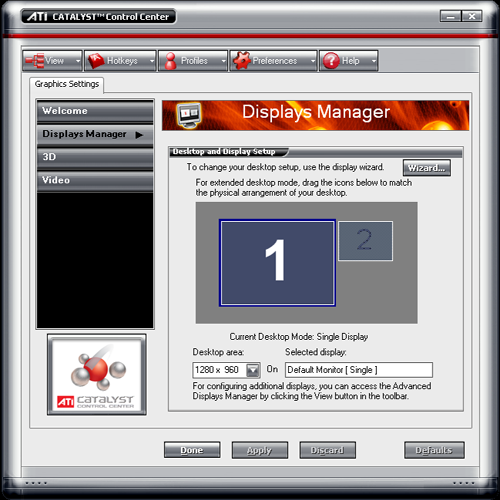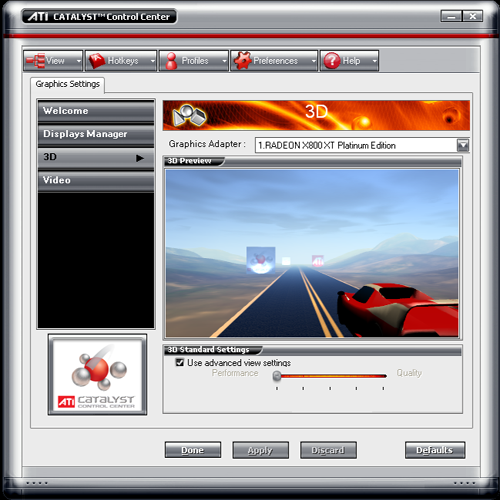New ATI Driver UI: The Catalyst Control Center
by Derek Wilson on September 2, 2004 6:00 AM EST- Posted in
- GPUs
Simplifying Settings
The first thing that we noticed (aside from the skin) about the CCC is just how clean and simple it is. We do prefer a consistent UI look and feel, but the layout of and obviousness of where everything is helps immensely in getting around.
The tabs at the side clearly talk about what they are, and have only the most straight forward, basic, and necessary options inside. For instance, the Display manager offers resolution and multi-monitor setup options with a wizard button at the top, if you need help.

The wizard asks really basic questions about what type of monitor and setup that it's working with and comes up with settings based on the answers.
The simple 3D view is where things get really innovative. ATI has embedded a small OpenGL app into the CCC, which updates in real time as settings are changed. This allows the user to move the slider (siders in the advanced view) to determine exactly what will happen to their games. The inclusion of this feature will help in educating ATI users about what a setting does, and will also get more people hooked on the almost crack-like properties that high levels of anisotropic filtering and antialiasing have (when you see what they do visually, it's easier to tell when they aren't cranked up).

This is the must-have feature that ATI has included in the CCC. We want NVIDIA, Intel, and S3 to pick this up and run with it. It's just that helpful to new users and could help people adjust their settings in a useful way. And if the windowed mode isn't enough to help get the idea of what's going on, just double-click the scene and it'll go full screen.
The only downside that we've seen so far is that this new feature makes moving a slider a bit of a chore. The performance hit incurred by moving a slider on our x800XTPE in an FX53 system with 2GB of RAM qualifies as annoying if we are being kind. ATI has said that they are addressing performance related issues; hopefully, future releases will see faster response time.
But that's enough of the simple stuff. Let's take a look at the advanced view and find out what else this baby can do.










51 Comments
View All Comments
Bluefront - Monday, September 6, 2004 - link
So is this new control panel of any use to a non-gamer? Will it have any benefits to people who use AIW cards for their multi-media capabilities?bobbenedetti - Sunday, September 5, 2004 - link
On my computer with Windows XP SP2 CCC stumbles through half a dozen errors on startup delaying startup of my antivirus and messenger.Way too much overhead for what it does.
I deleted it.
HermosaBeach - Sunday, September 5, 2004 - link
Questsion - I downloaded the new full package (driver and new CCC) on Sept 3. It was 42 MB. I then uninstalled my old 4.8 with the old control panel, rebotted, and then installed the new one. My control panel still looks like the old one ? Is there something I have to do to get the control panel to switch to the new looking skin ? I would like to try out the anti-aliasing and AF demo.Dave
Reflex - Saturday, September 4, 2004 - link
val - I have serious difficulty believing your claims. Nearly every programmer I know would laugh silly at what your saying. Yes there is a place for ASM, however there is also a reason we developed higher level languages.As for the 'driver' taking up more memory...well, who cares if it does not impact performance in any way, shape, or form, which is my point. Memory management means more than memory footprint these days. Its part of the point of .NET. You can go on about how its not asthetically pleasing to you to see a driver taking up so much, but when it comes down to it, its an argument of what you 'like' rather than any valid complaint about the driver or its performance impact on your system.
val - Saturday, September 4, 2004 - link
last but not least, little more time you spend will save lot of time of all users of your applications.val - Saturday, September 4, 2004 - link
And to your examples, i am not student anymore, i must not write again what was already written. But thinking in ASM makes you better programmer. Not like you see in many C codes, where many users are not thinking about how each function will take long time to execute (for example usage of timer related code or string related code in many games in main thread, no use for binary search where it is possible, no use of hash search where it helps,...).Valerie
val - Saturday, September 4, 2004 - link
JarredWalton: i am ASM programmer, and trust me or not it takes no longer time. I do not write whole program in ASM, but nearly all executive functions. In fact, the programming of alghoritms is not easier in C/C++ because functions are more or less same. Many functions you have not in C at all or it is too complicated to use (SSE,...). C is easier for OS related code, and so on.For example I wrote SD card reading/writing for PIC whole in ASM, you cannot do it faster in C, only searching and installing compiler will take you longer. Same with my other projects. Just write the frame in C, executive functions in ASM. What C have what ASM not?
JarredWalton - Saturday, September 4, 2004 - link
"assembly code is not about to debug ten years, it is about to write code for same time but write it good."That sounds like something a person who has never written assembly would say. My ASM experience amounts to one class. The final project was a stinking bubble sort algorithm! Sort 10000 integers using a bubble sort. God, I could write that up in C in about an hour, probably less.
Well, that simple project took roughly two weeks of my life, and I was probably the best ASM programmer in the class. Half of my time in the computer lab was spent helping other people figure out why the hell their computer kept crashing every time they ran their code. (Ah, the joys of the old Mac OS with no protected memory....)
If you still don't get it, read that again. A BUBBLE SORT algorithm took two weeks to write in assembly! Granted, I was a programming neophyte back then, but I doubt anyone could write and debug an ASM routine to do a bubble sort in less than a day (without copying/reusing existing code).
Sure, it was fast when it was done, but I could have written a quick sort algorithm in C in less time that would have been much faster due to the use of a better algorithm. If you think writing a bubble sort in ASM would be hard, try writing a quick sort....
val - Saturday, September 4, 2004 - link
Reflex: i agree with you and i will not complain about usage of game, office or photoshop, but drivers?! Resident services and applications must be small!val - Saturday, September 4, 2004 - link
assembly code is not about to debug ten years, it is about to write code for same time but write it good.And memory usage hurts performance, because many applications are checking how much memory is available before they will alocate it. And i do not like swapping.